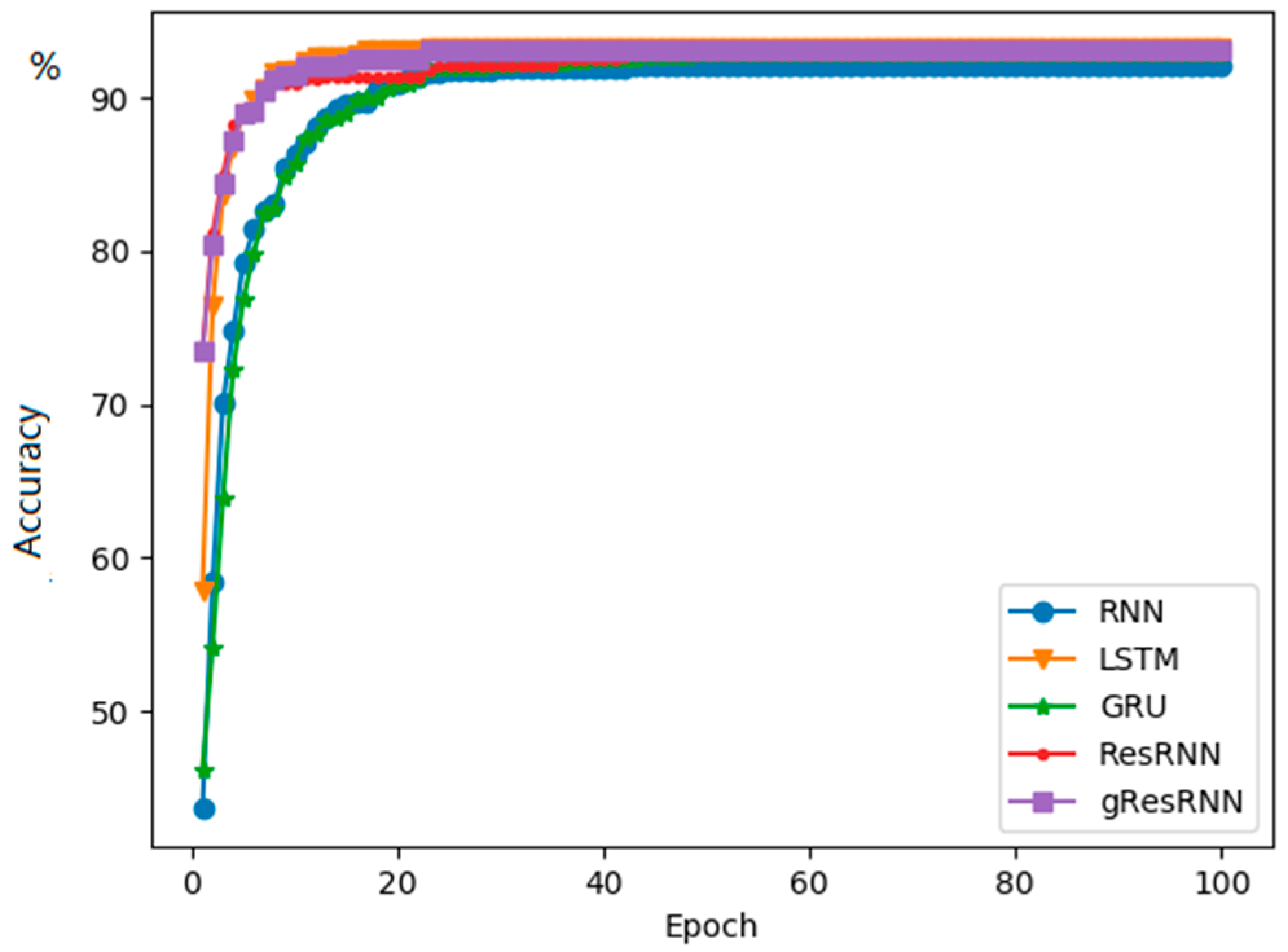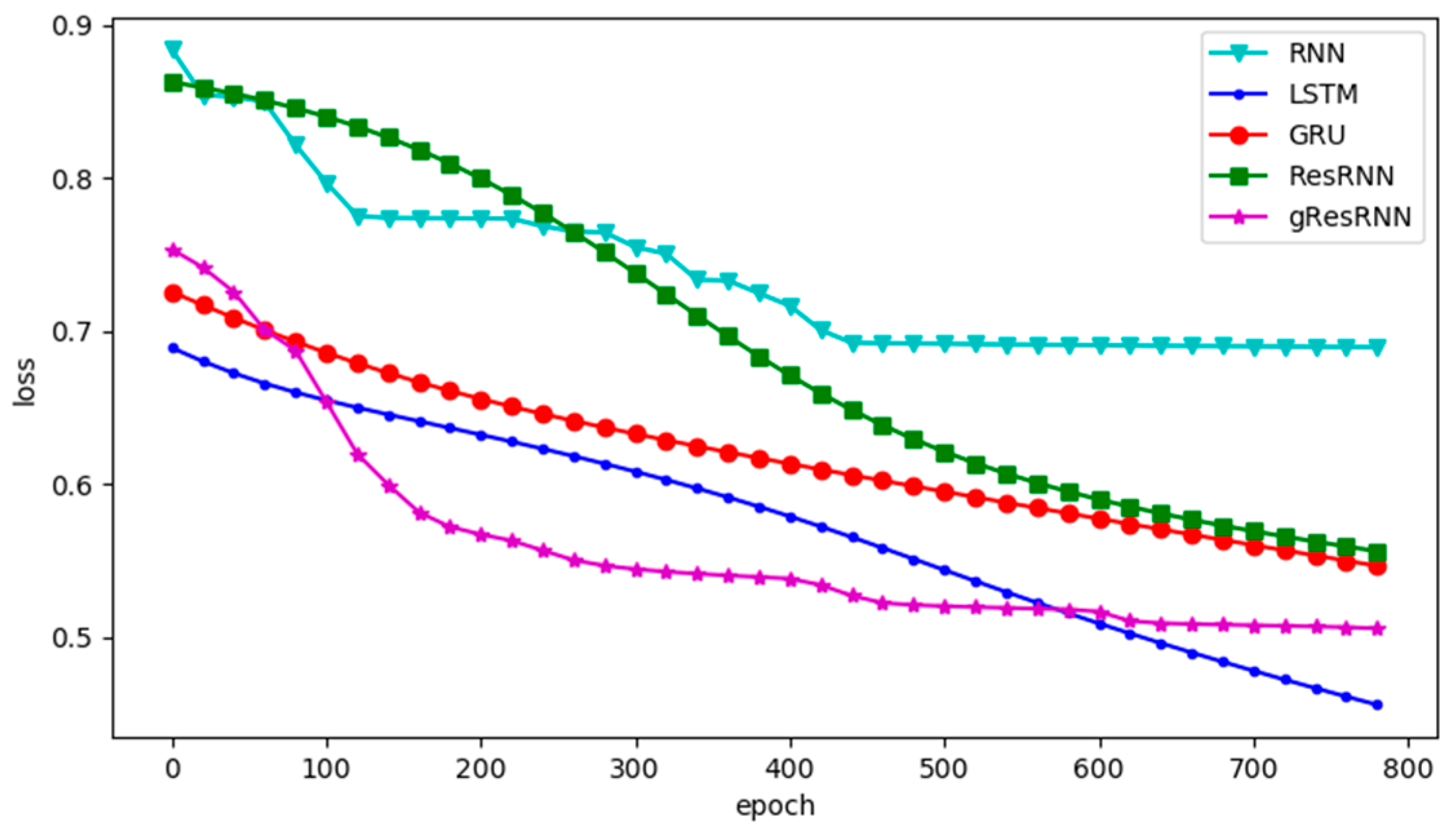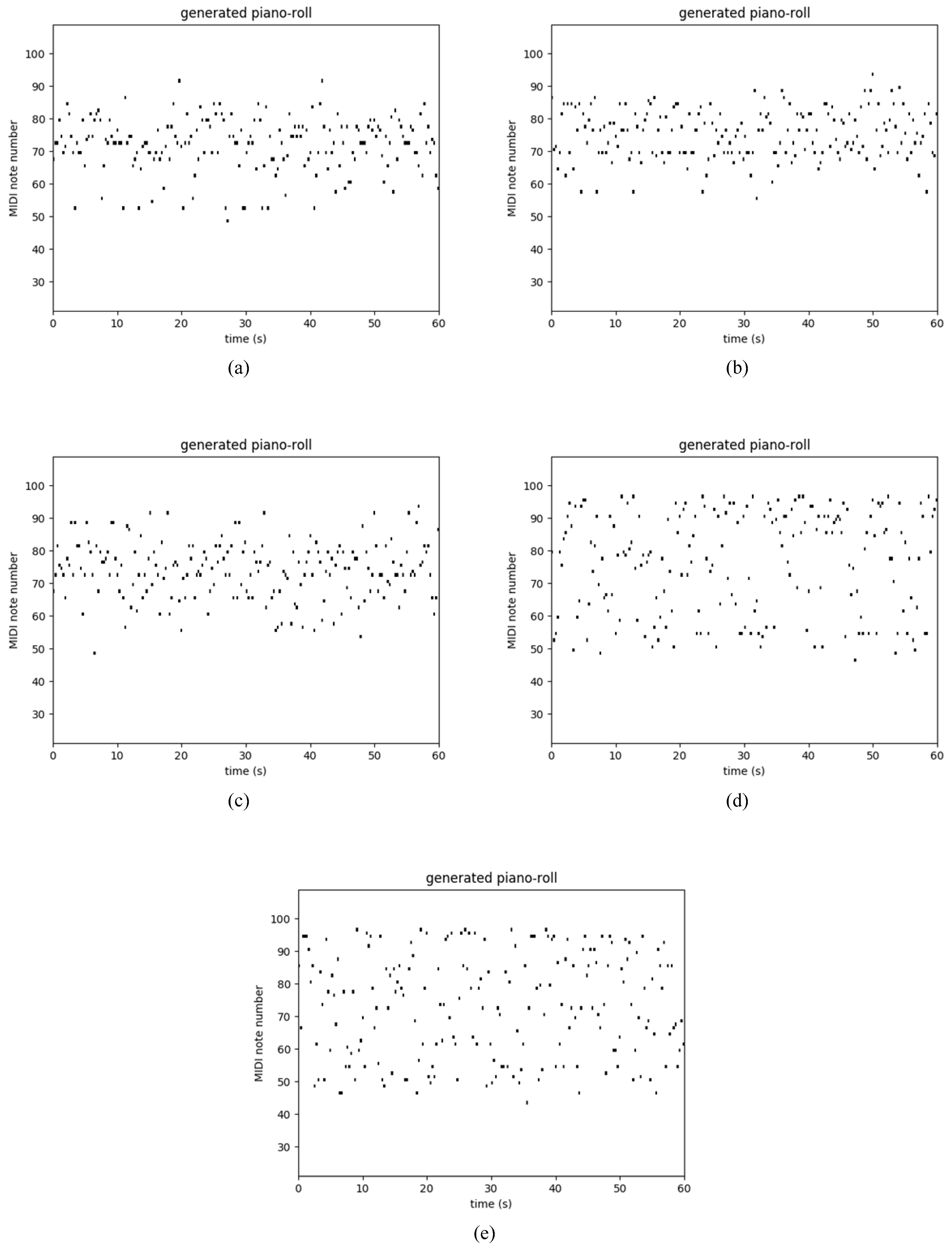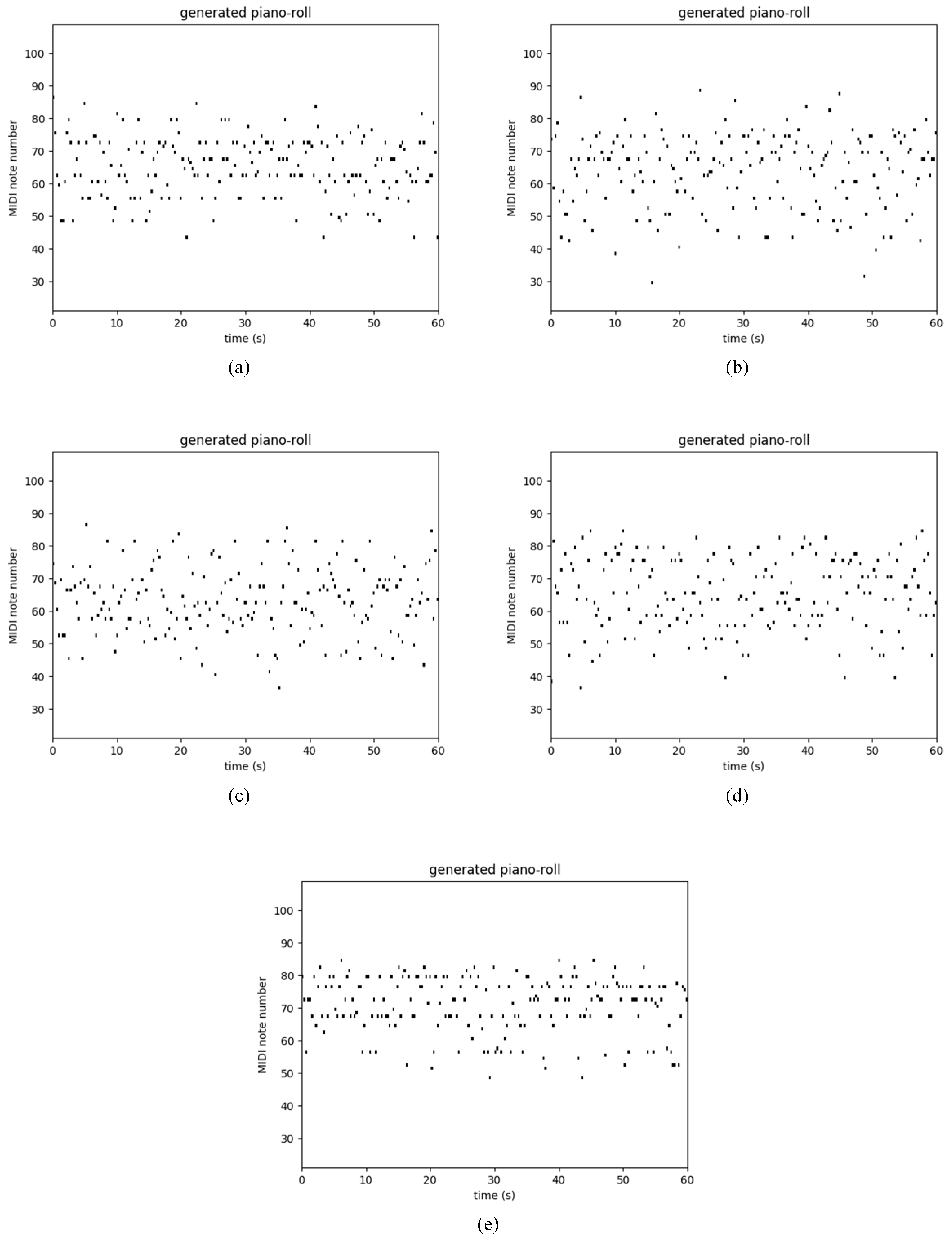Residual Recurrent Neural Networks for Learning Sequential Representations
Abstract
:1. Introduction
2. Recurrent Neural Networks and Its Training
2.1. Gradient Issues
2.2. Residual Learning and Identity Mapping
3. Residual Recurrent Neural Network
3.1. Residual-Shortcut Structure
3.2. Analysis of Res-RNN
4. Experiments and Discussion
4.1. ATIS Database
4.2. IMDB Database
4.3. Polyphonic Databases
5. Conclusions
Acknowledgments
Author Contributions
Conflicts of Interest
References
- Hinton, G.; Deng, L.; Yu, D.; Dahl, G.E.; Mohamed, A.; Jaitly, N.; Senior, A.; Vanhoucke, V.; Nguyen, P.; Sainath, T.N. Deep neural networks for acoustic modeling in speech recognition: The shared views of four research groups. IEEE Signal Process. Mag. 2012, 29, 82–97. [Google Scholar] [CrossRef]
- Mohamed, A.; Dahl, G.E.; Hinton, G. Acoustic modeling using deep belief networks. IEEE Trans. Audio Speech Lang. Process. 2012, 20, 14–22. [Google Scholar] [CrossRef]
- Jackson, R.G.; Patel, R.; Jayatilleke, N.; Kolliakou, A.; Ball, M.; Gorrell, G.; Roberts, A.; Dobson, R.J.; Stewart, R. Natural language processing to extract symptoms of severe mental illness from clinical text: The clinical record interactive search comprehensive data extraction (cris-code) project. BMJ Open 2017, 7, e012012. [Google Scholar] [CrossRef] [PubMed]
- Swartz, J.; Koziatek, C.; Theobald, J.; Smith, S.; Iturrate, E. Creation of a simple natural language processing tool to support an imaging utilization quality dashboard. Int. J. Med. Inform. 2017, 101, 93–99. [Google Scholar] [CrossRef] [PubMed]
- Sawaf, H. Automatic Machine Translation Using User Feedback. U.S. Patent US20150248457, 3 September 2015. [Google Scholar]
- Sonoo, S.; Sumita, K. Machine Translation Apparatus, Machine Translation Method and Computer Program Product. U.S. Patent US20170091177A1, 30 March 2017. [Google Scholar]
- Gallos, L.K.; Potiguar, F.Q.; Andrade, J.S., Jr.; Makse, H.A. Imdb network revisited: Unveiling fractal and modular properties from a typical small-world network. PLoS ONE 2013, 8, e66443. [Google Scholar] [CrossRef]
- Oghina, A.; Breuss, M.; Tsagkias, M.; Rijke, M.D. Predicting imdb movie ratings using social media. In Advances in Information Retrieval, Proceedings of the European Conference on IR Research, ECIR 2012, Barcelona, Spain, 1–5 April 2012; Springer: Berlin/Heidelberg, Germany, 2012; pp. 503–507. [Google Scholar]
- Elman, J.L. Finding structure in time. Cogn. Sci. 1990, 14, 179–211. [Google Scholar] [CrossRef]
- Jordan, M.I. Serial Order: A Parallel Distributed Processing Approach; University of California: Berkeley, CA, USA, 1986; Volume 121, p. 64. [Google Scholar]
- Bengio, Y.; Boulanger-Lewandowski, N.; Pascanu, R. Advances in optimizing recurrent networks. In Proceedings of the IEEE International Conference on Acoustics, Speech and Signal Processing, Kyoto, Japan, 25–30 March 2012; pp. 8624–8628. [Google Scholar]
- Bengio, Y.; Frasconi, P.; Simard, P. The problem of learning long-term dependencies in recurrent networks. In Proceedings of the IEEE International Conference on Neural Networks, San Francisco, CA, USA, 28 March–1 April 1993; Volume 1183, pp. 1183–1188. [Google Scholar]
- Bengio, Y.; Simard, P.; Frasconi, P. Learning long-term dependencies with gradient descent is difficult. IEEE Trans. Neural Netw. 1994, 5, 157–166. [Google Scholar] [CrossRef] [PubMed]
- Gustavsson, A.; Magnuson, A.; Blomberg, B.; Andersson, M.; Halfvarson, J.; Tysk, C. On the difficulty of training recurrent neural networks. Comput. Sci. 2013, 52, 337–345. [Google Scholar]
- Sutskever, I. Training Recurrent Neural Networks. Ph.D. Thesis, University of Toronto, Toronto, ON, Canada, 2013. [Google Scholar]
- Sepp, H.; Schmidhuber, J. Long short-term memory. Neural Comput. 1997, 9, 16. [Google Scholar]
- Cho, K.; Merrienboer, B.V.; Gulcehre, C.; Bahdanau, D.; Bougares, F.; Schwenk, H.; Bengio, Y. Learning phrase representations using rnn encoder-decoder for statistical machine translation. arXiv, 2014; arXiv:1406.1078. [Google Scholar]
- He, K.; Zhang, X.; Ren, S.; Sun, J. Deep residual learning for image recognition. In Proceedings of the Computer Vision and Pattern Recognition, Caesars Palace, NE, USA, 26 June–1 July 2016; pp. 770–778. [Google Scholar]
- He, K.; Zhang, X.; Ren, S.; Sun, J. Identity mappings in deep residual networks. In Proceedings of the European Conference on Computer Vision, Amsterdam, The Netherlands, 11–14 October 2016. [Google Scholar]
- Russakovsky, O.; Deng, J.; Su, H.; Krause, J.; Satheesh, S.; Ma, S.; Huang, Z.; Karpathy, A.; Khosla, A.; Bernstein, M. Imagenet large scale visual recognition challenge. Int. J. Comput. Vis. 2015, 115, 211–252. [Google Scholar] [CrossRef]
- Szegedy, C.; Ioffe, S.; Vanhoucke, V.; Alemi, A. Inception-v4, inception-resnet and the impact of residual connections on learning. In Proceedings of the Thirty-First AAAI Conference on Artificial Intelligence, San Francisco, CA, USA, 4–9 February 2017; p. 12. [Google Scholar]
- Price, P.J. Evaluation of spoken language systems: The atis domain. In Proceedings of the Workshop on Speech and Natural Language, Harriman, NY, USA, 23–26 February 1992; pp. 91–95. [Google Scholar]
- Lindsay, E.B. The internet movie database (imdb). Electron. Resour. Rev. 1999, 3, 56–57. [Google Scholar]
- Chung, J.; Gulcehre, C.; Cho, K.H.; Bengio, Y. Empirical evaluation of gated recurrent neural networks on sequence modeling. arXiv, 2014; arXiv:1412.3555. [Google Scholar]
- Ioffe, S.; Szegedy, C. Batch normalization: Accelerating deep network training by reducing internal covariate shift. In Proceedings of the 32nd International Conference on Machine Learning, Lille, France, 7–9 July 2015; pp. 448–456. [Google Scholar]
- Szegedy, C.; Liu, W.; Jia, Y.; Sermanet, P.; Reed, S.; Anguelov, D.; Erhan, D.; Vanhoucke, V.; Rabinovich, A. Going deeper with convolutions. In Proceedings of the 2015 IEEE Conference on Computer Vision and Pattern Recognition (CVPR), Boston, MA, USA, 7–12 June 2015; pp. 1–9. [Google Scholar]
- Szegedy, C.; Vanhoucke, V.; Ioffe, S.; Shlens, J.; Wojna, Z. Rethinking the inception architecture for computer vision. In Proceedings of the IEEE Conference on Computer Vision and Pattern Recognition, Seattle, WA, USA, 27–30 June 2016; pp. 2818–2826. [Google Scholar]
- Jegou, H.; Perronnin, F.; Douze, M.; Sanchez, J.; Perez, P.; Schmid, C. Aggregating local image descriptors into compact codes. IEEE Trans. Pattern Anal. Mach. Intell. 2012, 34, 1704. [Google Scholar] [CrossRef] [PubMed] [Green Version]
- Perronnin, F.; Dance, C. Fisher kernels on visual vocabularies for image categorization. In Proceedings of the IEEE Conference on Computer Vision and Pattern Recognition (CVPR ’07), Minneapolis, MN, USA, 18–23 June 2007; pp. 1–8. [Google Scholar]
- Jégou, H.; Douze, M.; Schmid, C. Product quantization for nearest neighbor search. IEEE Trans. Pattern Anal. Mach. Intell. 2011, 33, 117. [Google Scholar] [CrossRef] [PubMed] [Green Version]
- Belayadi, A.; Ait-Gougam, L.; Mekideche-Chafa, F. Pattern Recognition and Neural Networks; Cambridge University Press: Cambridge, UK, 1996; pp. 233–234. [Google Scholar]
- Sermanet, P.; Eigen, D.; Zhang, X.; Mathieu, M.; Fergus, R.; Lecun, Y. Overfeat: Integrated recognition, localization and detection using convolutional networks. arXiv, 2014; arXiv:1312.6229. [Google Scholar]
- Fahlman, S.E.; Lebiere, C. The cascade-correlation learning architecture. Adv. Neural Inf. Process. Syst. 1991, 2, 524–532. [Google Scholar]
- Srivastava, R.K.; Greff, K.; Schmidhuber, J. Highway networks. arXiv, 2015; arXiv:1505.00387. [Google Scholar]
- Cooijmans, T.; Ballas, N.; Laurent, C.; Gülçehre, Ç.; Courville, A. Recurrent batch normalization. arXiv, 2016; arXiv:1603.09025. [Google Scholar]
- Mesnil, G.; He, X.; Deng, L.; Bengio, Y. Investigation of recurrent-neural-network architectures and learning methods for spoken language understanding. In Proceedings of the Interspeech Conference, Lyon, France, 25–29 August 2013. [Google Scholar]
- Graves, A. Supervised Sequence Labelling with Recurrent Neural Networks; Springer: Berlin/Heidelberg, Germany, 2012. [Google Scholar]
- Boulangerlewandowski, N.; Bengio, Y.; Vincent, P. Modeling temporal dependencies in high-dimensional sequences: Application to polyphonic music generation and transcription. Chem. A Eur. J. 2012, 18, 3981–3991. [Google Scholar]









| RNN | LSTM | GRU | Res-RNN | gRes-RNN | ||
|---|---|---|---|---|---|---|
| Valid F1 | Mean | 95.63% | 96.58% | 95.63% | 95.87% | 96.53% |
| Std | 0.0142 | 0.0096 | 0.0132 | 0.0115 | 0.0101 | |
| Test F1 | Mean | 92.11% | 93.19% | 92.81% | 92.97% | 93.03% |
| Std | 0.0166 | 0.0092 | 0.0141 | 0.0120 | 0.0110 | |
| Valid Accuracy | Mean | 95.56% | 96.49% | 95.50% | 95.55% | 96.62% |
| Std | 0.0178 | 0.0082 | 0.0122 | 0.0097 | 0.0092 | |
| Test Accuracy | Mean | 91.81% | 92.77% | 92.54% | 92.50% | 92.62% |
| Std | 0.0168 | 0.0077 | 0.0134 | 0.0100 | 0.0083 | |
| Valid Recall | Mean | 95.85% | 96.75% | 96.00% | 96.20% | 96.60% |
| Std | 0.0173 | 0.0056 | 0.0144 | 0.0100 | 0.0099 | |
| Test Recall | Mean | 92.74% | 93.62% | 93.20% | 93.45% | 93.45% |
| Std | 0.0188 | 0.0043 | 0.0112 | 0.0105 | 0.0091 | |
| Time Consumption | 24.10 s | 63.59 s | 56.74 s | 29.10 s | 38.80 s | |
| Training Accuracy | Test Accuracy | Time Consumption | |||
|---|---|---|---|---|---|
| Mean | Std | Mean | Std | ||
| RNN | 93.91% | 0.0148 | 78.24% | 0.0232 | 51.32 s |
| LSTM | 99.97% | 0.0001 | 85.16% | 0.0023 | 208.44 s |
| GRU | 99.98% | 0.0001 | 85.84% | 0.0038 | 140.10 s |
| Res-RNN | 99.93% | 0.0003 | 84.78% | 0.0042 | 90.08 s |
| Res-RNN with gate | 99.95% | 0.0002 | 85.33% | 0.0029 | 123.22 s |
| RNN | LSTM | GRU | Res-RNN | gRes-RNN | ||
|---|---|---|---|---|---|---|
| Nottingham | Loss | 9.62 | 7.37 | 8.50 | 8.26 | 8.60 |
| Std | 1.63 | 0.54 | 0.72 | 0.89 | 0.66 | |
| Time | 10.45 s | 35.48 s | 27.32 s | 19.06 s | 25.01 s | |
| JSB Chorales | Loss | 9.04 | 7.43 | 8.54 | 7.60 | 7.77 |
| Std | 1.01 | 0.67 | 0.96 | 0.55 | 0.23 | |
| Time | 10.62 s | 35.50 s | 27.14 s | 18.92 s | 25.42 s | |
| MuseData | Loss | 10.42 | 9.62 | 9.86 | 9.31 | 8.93 |
| Std | 1.45 | 0.73 | 0.12 | 0.33 | 0.30 | |
| Time | 10.33 s | 35.39 s | 27.33 s | 19.13 s | 25.01 s | |
| Piano-midi | Loss | 11.71 | 9.57 | 9.62 | 8.22 | 9.26 |
| Std | 1.92 | 0.84 | 0.86 | 0.24 | 0.68 | |
| Time | 10.52 s | 35.44 s | 27.20 s | 19.44 s | 25.01 s | |
© 2018 by the authors. Licensee MDPI, Basel, Switzerland. This article is an open access article distributed under the terms and conditions of the Creative Commons Attribution (CC BY) license (http://creativecommons.org/licenses/by/4.0/).
Share and Cite
Yue, B.; Fu, J.; Liang, J. Residual Recurrent Neural Networks for Learning Sequential Representations. Information 2018, 9, 56. https://doi.org/10.3390/info9030056
Yue B, Fu J, Liang J. Residual Recurrent Neural Networks for Learning Sequential Representations. Information. 2018; 9(3):56. https://doi.org/10.3390/info9030056
Chicago/Turabian StyleYue, Boxuan, Junwei Fu, and Jun Liang. 2018. "Residual Recurrent Neural Networks for Learning Sequential Representations" Information 9, no. 3: 56. https://doi.org/10.3390/info9030056





